Tire shop refuses to do tire repair
Why tire shops refuse to do a tire repair
Tire shops follow recommended tire repair techniques and procedures published by the U.S. Tire Manufacturers Association. Their guidelines specify which types of punctures, cuts and scrapes are repairable and which areas of the tire can be repaired. If your tire damage falls outside of those recommendations, the tire shop will refuse to perform a tire repair due because the tire would no longer be road worthy. No tire shop wants to be held responsible for injury or vehicle damage due to perform an unauthorized tire repair.
A quick look at tire construction
If you understand how a tire is built, then the tire repair guidelines will make sense to you. We all know what tire tread is and that what we think needs to be patched when there’s a puncture. Wrong! The most important component is the INNERLINER because that’s what keeps air in the tire. If you patch the tread without performing a proper repair on the innerliner, the tire will fail.
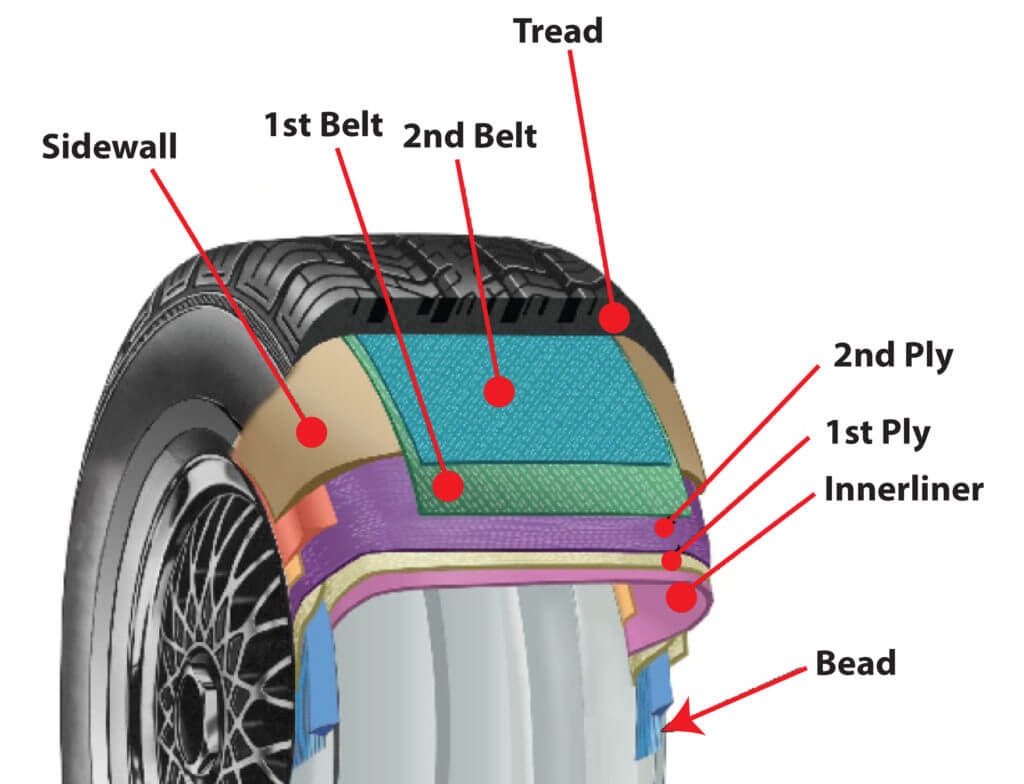
Innerliner – The innerliner is made from a rubber compound and its sole job is to retain inflation pressure.
Sidewall – The sidewall is often the thinnest part of the tire and it provides stability in turns as well as abrasion, scuff and weather resistance.
Plies – Plies not only provide the structure of the tire but also act to keep the innerliner from bulging like a balloon when squeezed. Depending on whether the tire is for passenger or truck use it can have two or more body plies. The plies are a woven fabric made from polyester, rayon or nylon that embed into the rubber during the manufacturing process.
Belts – Similar to plies, the belts are mesh-like components often made from steel cords weaved at opposite angles. The belt provide the foundation for the tread and contribute to wear, handling and traction.
Tread – The tread provides traction/grip as well as water removal from the road surface. It is considered a wear component.
Bead – The bead is composed of wire strands that secure the tire to the wheel. .
What types of tire punctures, cuts and scrapes can be repaired?
Now that you’ve seen the cross section of the tire, it’s important to realize that when you get a flat tire, you’ve actually punctured a hole through the tread, belts, plies and innerliner. All three must be sealed in order for the tire to perform safely. But here’s the really important part: if you drove on the flat tire, even for a short distance, you’ve caused the innerliner of the sidewall of the tire to rub against the innerliner below the plies! That’s like rubbing two erasers together and it can weaken the innerliner. That’s why every flat tire must be dismounted from the wheel for a complete innerliner inspection.
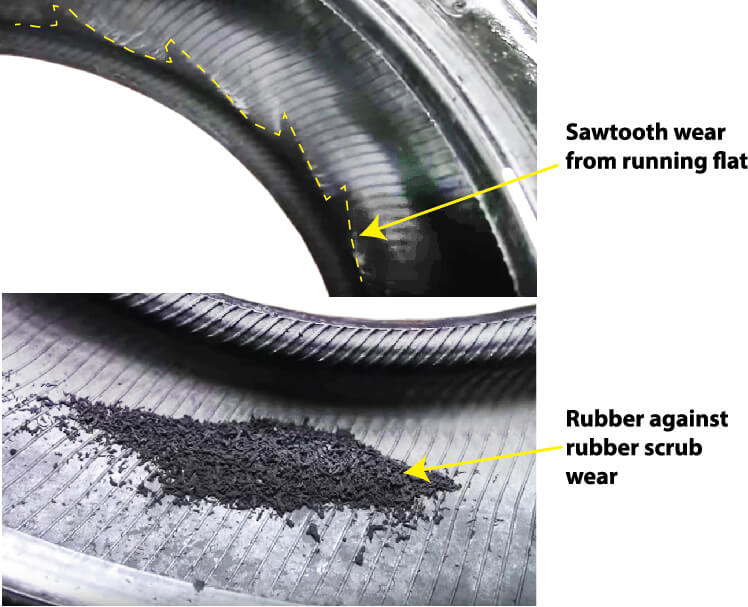
This is what happens to the inside of the tire when you drive on a flat tire.
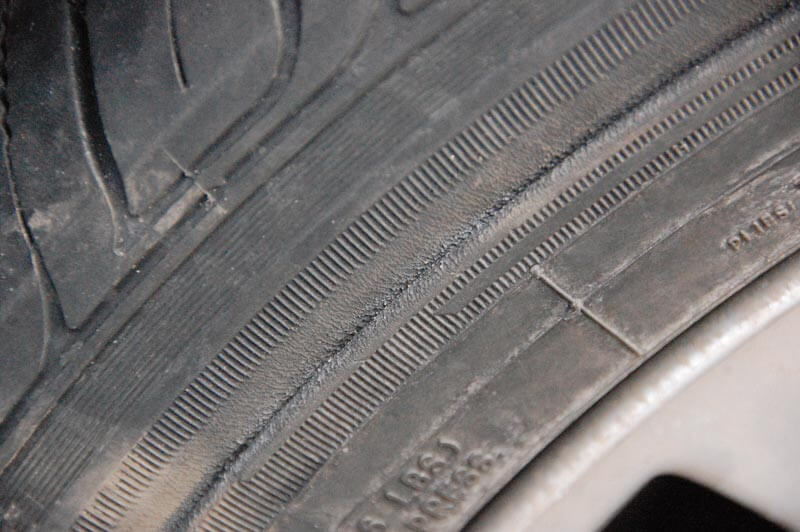
This is what happens to the sidewall when you drive on a flat tire
A puncture can be repaired IF:
• The puncture is within the tread area and at least 1-in. away from the shoulder
• The puncture must be ¼-in in diameter or less
• The puncture must not exceed a 45° angle
• The puncture must not overlap a previous tire repair.
• The sidewall and innerliner must be inspected to ensure there’s no damage
Puncture repair guidelines
Punctures up to ¼-in in diameter can be
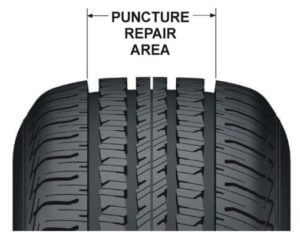
Safe tire repair area
safely repaired using both an innerliner patch and a plug or a combination patch plug AS LONG AS the puncture area is located in the approved repair area shown in this image. In other words, punctures in the tread that are at least 1-in. away from the tire shoulder are repairable. A patch alone or a plug alone is NOT an acceptable repair.
The patch seals the innerliner and prevents air from reaching the belts and plies. A string plug fills the patch of the puncture but does not seal the innerliner. A plug alone can allow air to migrate into the belts and plies and cause early failure.
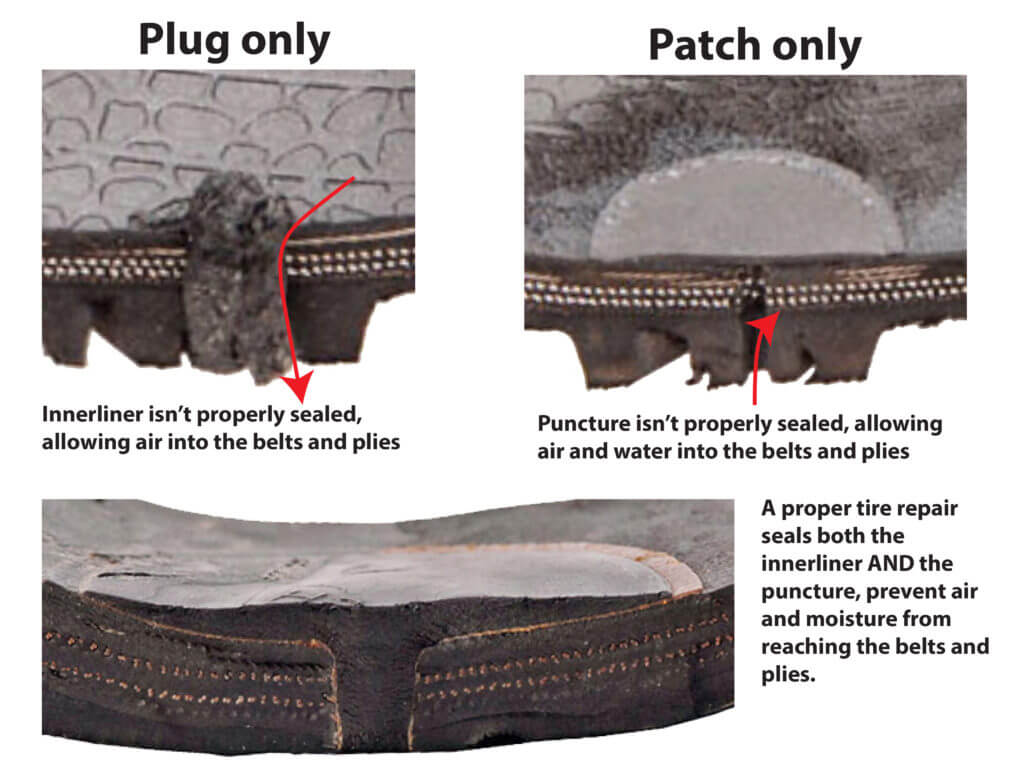
A plug alone is NOT an acceptable repair. A patch alone is NOT an acceptable repair.
Puncture repair procedure
Tire plug preparation and installation
Because a puncture doesn’t usually provide a clean cut through the tire, the first step in tire repair is to run a carbide drill through 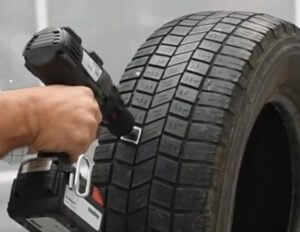 the hole to obtain a uniform diameter and remove rubber fibers that might prevent a good bond. The technician then blows out any rubber particles from the newly drilled hole and coats the inside of the hole with an adhesive. Then the rope plug is installed and allowed to set up. The technician then cuts off the excess plug material from the tread and cuts the interior portion of the plug so it is flush with the innerliner.
the hole to obtain a uniform diameter and remove rubber fibers that might prevent a good bond. The technician then blows out any rubber particles from the newly drilled hole and coats the inside of the hole with an adhesive. Then the rope plug is installed and allowed to set up. The technician then cuts off the excess plug material from the tread and cuts the interior portion of the plug so it is flush with the innerliner.
Drilling the hole with a carbide bit is critical to
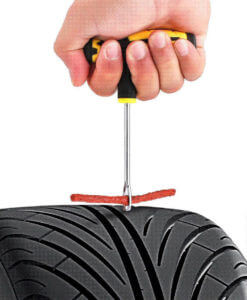
Inserting a tire plug
removing treads of ply and belt material from the puncture and helps obtain a smooth bonding surface for the plug to adhere to.
Tire patch preparation and installation
The innerliner must first be prepared using a buffing wheel to slightly scuff the innerliner. Scuffing allows the patch adhesive to “bite” into freshly exposed rubber and that improves adhesion and sealing. Next, the technician applies a special butyl liner adhesive to the innerliner, applies the patch and then rolls the patch using a special tool. Rolling the patch is referred to as “stitching” and is critical to maintaining a good bond.

Buffing tire innerliner
Punctures, bubbles, cuts and scrapes that cannot be repaired
• Sidewall punctures can never be repaired due to the high degree of flex and heat that’s always present in the sidewall
• Punctures in the tire’s shoulder area cannot be repaired
• Slices cannot be repaired
• Scrapes in the sidewall rubber cannot be repaired if the scrape has damaged any of the ply or belt fabric.
©, 2019 Rick Muscoplat
Posted on by Rick Muscoplat